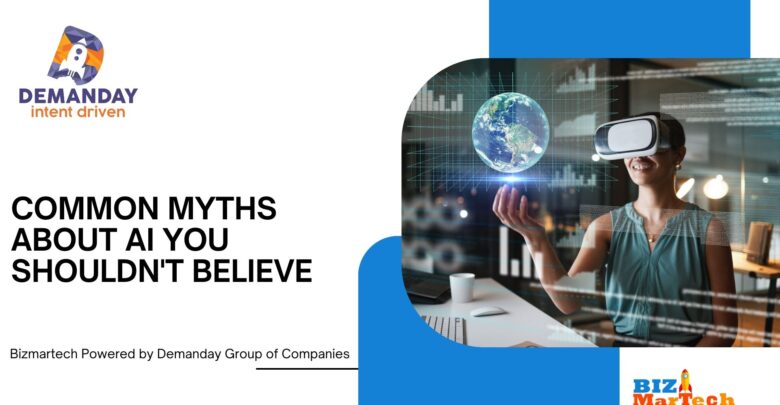AI
Common Myths About AI You Shouldn’t Believe

Artificial Intelligence (AI) is rapidly evolving and increasingly becoming a part of everyday life, from voice assistants like Siri and Alexa to complex data analysis in industries such as healthcare, finance, and logistics. Despite its prominence, many misconceptions about AI still exist, fueling misunderstandings and unrealistic expectations. Here, we debunk some of the most common myths about AI to give you a clearer understanding of what this technology can and cannot do.
1. AI Can Think and Feel Like Humans
Myth: AI has human-like consciousness and emotions, meaning it can think and feel just like a person.
Reality: AI, as we know it today, lacks consciousness, emotions, and subjective experiences. While AI can simulate certain human behaviors—such as recognizing faces, processing language, and making decisions based on data—it does not have thoughts, feelings, or awareness. AI systems operate through algorithms that process data and respond based on pre-set rules or learned patterns; they do not “think” or “feel” in any human sense.
Why This Myth Exists: The idea of sentient AI is popularized by movies and media that depict robots and AI with human-like qualities. Films such as Ex Machina and Her present AI as self-aware entities capable of emotional connections and deep thought. In reality, AI lacks self-awareness and operates without any true understanding of the tasks it performs.
What It Means for You: AI is powerful in processing and analyzing vast amounts of data, but it remains fundamentally a tool. When using or interacting with AI systems, keep in mind that while they may seem “intelligent,” they are not conscious or capable of emotions.
2. AI Will Replace All Jobs
Myth: AI will soon take over all jobs, leaving humans unemployed and obsolete.
Reality: While AI will automate many tasks, it is unlikely to replace all jobs. AI excels at repetitive, data-driven, and predictable tasks, such as analyzing large datasets, sorting inventory, or even some customer service functions. However, jobs that require creativity, emotional intelligence, complex problem-solving, and human judgment—such as healthcare, education, and creative professions—are not as easily replaced by AI.
Why This Myth Exists: The rise of automation and intelligent systems has led to fears that robots will replace human workers. High-profile cases like self-driving cars and automated manufacturing have fueled this perception. While automation will transform certain job sectors, it will also create new roles that require human oversight, management, and creative skills.
What It Means for You: It’s crucial to view AI as a tool that can enhance human productivity rather than replace it entirely. Upskilling and adapting to new technologies will help workers stay relevant and find new opportunities in an AI-driven world.
3. AI Is Infallible and Free of Bias
Myth: AI makes decisions based solely on facts and is free of biases.
Reality: AI systems are only as unbiased as the data they are trained on. If training data contains biases—whether due to historical inequities, flawed data collection processes, or human prejudice—AI can and will reflect those biases in its outputs. This has led to real-world problems such as biased hiring algorithms, facial recognition software that misidentifies certain demographic groups, and flawed predictive policing tools.
Why This Myth Exists: AI is often perceived as a logical, data-driven tool that acts without human influence. The belief that AI is objective and neutral is a common misconception, but it fails to take into account that the people who create and train AI are humans with biases themselves.
What It Means for You: When deploying or interacting with AI systems, it’s essential to be aware of their limitations and potential for bias. Organizations should strive to use diverse and representative datasets, as well as implement regular audits to ensure fairness and accuracy in AI outputs.
4. AI Can Solve Any Problem
Myth: AI can be used to solve any problem, no matter how complex.
Reality: While AI is incredibly powerful for certain types of problems—such as analyzing trends, automating routine tasks, and making predictions—it is not a universal solution. AI has limitations, including difficulty with understanding context, handling ambiguous data, and making decisions in unpredictable situations. It is highly specialized, meaning it can only perform tasks it was specifically trained for or programmed to do.
Why This Myth Exists: Many tech companies and media outlets hype up the capabilities of AI, suggesting that it can solve nearly any problem. Stories about breakthroughs in fields like medicine, where AI has helped identify patterns in medical data and accelerated drug discovery, can create unrealistic expectations about the technology’s potential.
What It Means for You: AI is an extremely valuable tool, but it should be seen as part of a larger solution involving human input and oversight. AI can enhance decision-making and efficiency, but it isn’t a magic bullet that can solve all challenges without human guidance.
5. AI Will Create a Dystopian Future
Myth: AI will eventually become so advanced that it will take control, leading to a dystopian future with rogue machines and loss of human freedom.
Reality: The fear of AI becoming self-aware and rebellious is popular in science fiction, but it’s unlikely to happen with current and foreseeable AI technologies. AI is not capable of developing its own goals or motivations. Most experts in the field agree that we are far from creating general AI, or AGI (Artificial General Intelligence), which would be able to think and act like humans across all domains.
Why This Myth Exists: Pop culture has played a huge role in shaping the fear of AI. Movies like The Terminator and The Matrix depict AI turning against humanity, feeding a fear that technological advancement will inevitably lead to chaos. While there are real concerns about AI safety and misuse, the fear of a robotic uprising remains speculative and not grounded in the current capabilities of AI.
What It Means for You: While it’s important to have ethical guidelines and regulations in place to govern AI development, there is no immediate danger of an AI takeover. AI technology is built and maintained by people, and current systems require human oversight and input. The focus should be on ensuring responsible use of AI, addressing potential risks, and fostering collaborative efforts to manage its growth safely.
6. AI Is Only for Large Tech Companies
Myth: AI is too complicated and expensive, so only big tech companies can use it effectively.
Reality: While large tech companies have the resources to develop advanced AI systems, there is a growing ecosystem of AI tools and platforms available for businesses of all sizes. Open-source AI libraries, cloud-based machine learning platforms, and affordable software solutions have made it possible for small and medium-sized enterprises (SMEs) to leverage AI for everything from customer service to predictive analytics.
Why This Myth Exists: The success stories of AI being used by major corporations like Google, Amazon, and Facebook may create the perception that only large organizations have access to advanced AI. However, recent advancements have democratized AI, making it accessible to smaller companies and even individual entrepreneurs.
What It Means for You: AI can be an asset for businesses of all sizes. Whether you’re a small business owner looking to optimize operations or a solo entrepreneur exploring new technologies, AI is more accessible than ever. Start by exploring user-friendly platforms and tools that allow you to integrate AI into your workflow without needing a team of data scientists.


